|
& 78th Crescent - Kew Gardens Photo Gallery: Queens Blvd |
 |
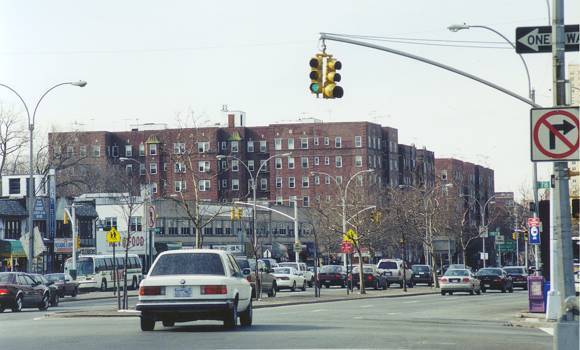
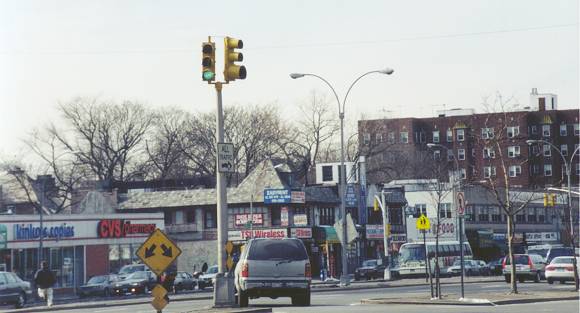
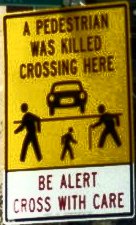 Few
Queens Boulevard crossings are more complex than that with Union
Turnpike, in no small part due to the fact that Union Turnpike
itself is so complex around here. Back in the 1930's, when the
boulevard itself and the subway beneath it were still taking
form, the parkway system was also in the halycon days of its
development. While most of the parkways had some measure of free
space around them, one remained rather cramped, crimped and otherwise
restricted; the Interboro, today known as the Jackie Robinson.
Into the already crowded Borough Hall section of Kew Gardens,
the Interboro needed to get from the Grand Central Pkwy down
to Forest Park, and all roads led straight through Union Turnpike.
The pike however, did not give ground easy. Few historical roads,
such as Boston Post in the Bronx, ever do. The end result was
that the pike was split in two and shoved to both sides, so that
the slim little parkway could snake its way through its center
median right of way. The two reluctant roomies nudge, shove and
squeeze one another through a series of sharp curves, steep grades
and constrictions as they navigate their collective way from
the Grand Central, under Queens Boulevard, up over the main branch
of the Long Island Railroad and on to Metropolitan Avenue, where
they finally part ways. Union Turnpike, however, was not satisfied
with being a mere adornment on the retaining walls of the Interboro.
It clung to its confluence with the great boulevard of Queens.
That was no longer to be what must have once been a simple affair
in the olden days of Hoffman Road. With a highway and its own
through express lanes now separating its northeast and southwest
bound side lanes, the Union Turnpike/Queens Boulevard crossing
had become a mammoth piece of real estate, stretching out to
encompass three other side streets meeting the boulevard, 78th
Crescent to the west and 80th and Kew Gardens Roads to the east.
Unlike the dangers facing those crossing the boulevard elsewhere,
where at least crossing the intersectors is relatively safe,
crossing the intersectors here is almost as much of a challenge
as the boulevard is. Few
Queens Boulevard crossings are more complex than that with Union
Turnpike, in no small part due to the fact that Union Turnpike
itself is so complex around here. Back in the 1930's, when the
boulevard itself and the subway beneath it were still taking
form, the parkway system was also in the halycon days of its
development. While most of the parkways had some measure of free
space around them, one remained rather cramped, crimped and otherwise
restricted; the Interboro, today known as the Jackie Robinson.
Into the already crowded Borough Hall section of Kew Gardens,
the Interboro needed to get from the Grand Central Pkwy down
to Forest Park, and all roads led straight through Union Turnpike.
The pike however, did not give ground easy. Few historical roads,
such as Boston Post in the Bronx, ever do. The end result was
that the pike was split in two and shoved to both sides, so that
the slim little parkway could snake its way through its center
median right of way. The two reluctant roomies nudge, shove and
squeeze one another through a series of sharp curves, steep grades
and constrictions as they navigate their collective way from
the Grand Central, under Queens Boulevard, up over the main branch
of the Long Island Railroad and on to Metropolitan Avenue, where
they finally part ways. Union Turnpike, however, was not satisfied
with being a mere adornment on the retaining walls of the Interboro.
It clung to its confluence with the great boulevard of Queens.
That was no longer to be what must have once been a simple affair
in the olden days of Hoffman Road. With a highway and its own
through express lanes now separating its northeast and southwest
bound side lanes, the Union Turnpike/Queens Boulevard crossing
had become a mammoth piece of real estate, stretching out to
encompass three other side streets meeting the boulevard, 78th
Crescent to the west and 80th and Kew Gardens Roads to the east.
Unlike the dangers facing those crossing the boulevard elsewhere,
where at least crossing the intersectors is relatively safe,
crossing the intersectors here is almost as much of a challenge
as the boulevard is.Above, traffic coming southwest from Union is only allowed to enter the boulevard going west, although vehicles are given the choice of cutting directly to the express lanes. Cars coming up from 78th Crescent, a mere few feet of median island from the Union lanes, must turn onto the boulevard's local lanes. As seen in the small building housing the Wireless store, Kew Gardens shared neighboring Forest Hills' penchant for Tudoresque architecture back in the 1920s. With several office buildings on the surrounding blocks, Kinko's Copying Service found a niche to fill. CVS, like its two main chain rivals, has become ubiquitous in the area. |
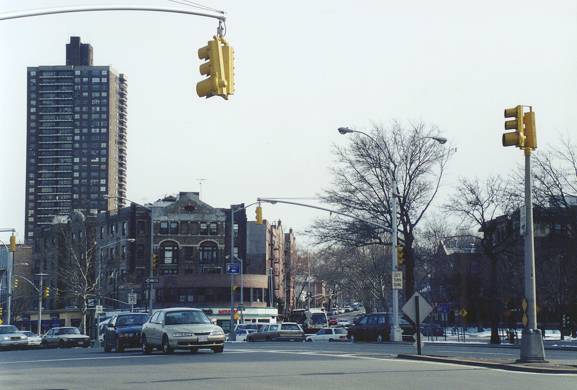
| Across the boulevard on the southeast side of the intersection is the confluence of Kew Gardens and 80th Roads, the former coming from straight back, while 80th comes in stage right. The two story rounded building at the corner houses the main subway entrance for the Union Tpke stop. The bus stopped on Kew Gardens Road will come around that building to loop east down Queens Boulevard on its way back towards where it came from. It was while turning onto the boulevard one night last December 2000, that a bus struck and killed 83 year old Eugene Eisenberg, who was ironically on his way to perform a ritual guard duty for a deceased friend at a nearby funeral home. |
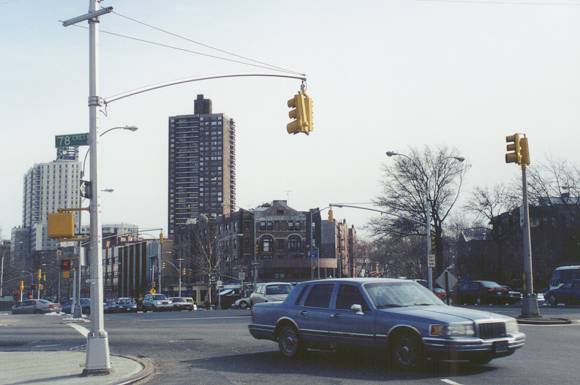
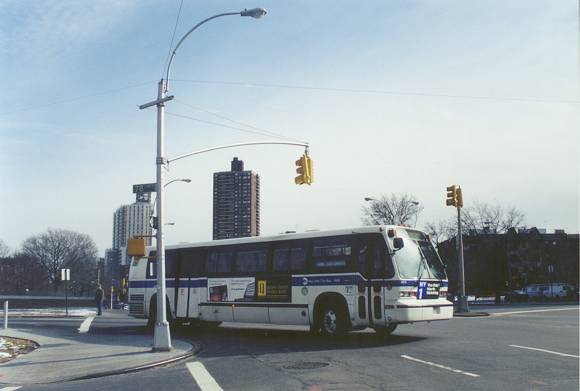
| Looking east from 78th Crescent, it is clear that the 80th Road spot is not the only place where turning busses present a hazard. The city run and city bound Q46 turns off Union Turnpike here, as does every vehicle entering this intersection from there. |
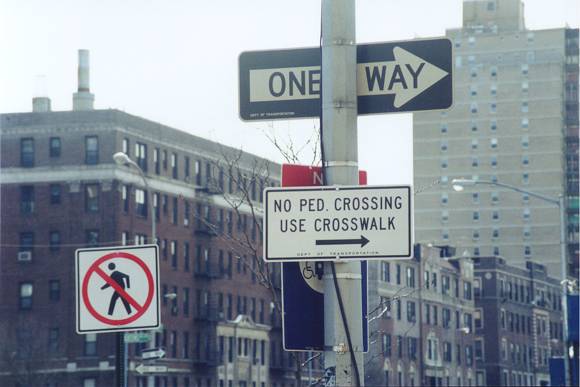
| The inherent hazards thus presented led to a closing of this side to cross-boulevard pedestrians. I've always thought that the "No Ped" sign was rather lacking. The traditional illiterate solution of the red circle/black line sign hopefully serves to clarify matters. |
©2001, Jeff Saltzman. All right reserved.